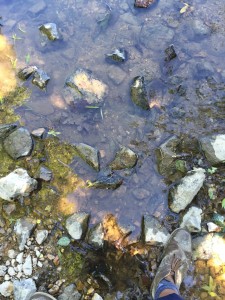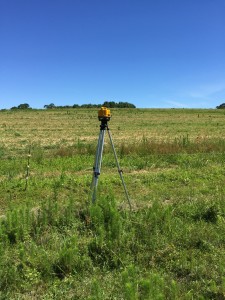This week I had the opportunity to go out into the field with Kyle Gentry from the Person County Soil and Water office. We also worked with Bill Woods and Harrison Tillman from the Natural Resources Conservation Service (NRCS). Here’s some info on Soil and Water:
North Carolina has 96 local soil and water conservation districts. The purpose of the local divisions is to “provide technical, financial, and educational assistance to the citizens of Person County.” Soil and Water is non-regulatory, and they focus on offering incentives to farmers to encourage responsible land and water management practices.
Depending on the types of projects being performed, a landowner may be able to take advantage of cost-share funding. According to the NC Department of Agriculture and Consumer Services, typically 75% cost-share assistance is provided to an applicant to implement best management practices that benefit all citizens by improving water resources in North Carolina. This assists in subsidizing the cost of projects and encouraging best management practices.
The specific project I assisted on involved surveying farmland in preparation for constructing a waterway crossing for cattle.

We met up with the family that owned the farm and drove down to where the crossing would be located. Upon stepping out of the truck, I realized that I wasn’t dressed the best for field work. Everyone had rubber boots and I was rocking desert boots. This didn’t deter me, though! I rolled up my pant’s legs and got to work (Fortunately, I was wearing nice socks)
Our survey effort was led by Bill Woods from the Natural Resources Conservation Service. Land surveying involves three steps:

1. Determining distance;
2. Determining elevation, and
3. Measuring angles
The surveying process started with setting up a laser level. The laser level–which many of us have seen driving near a construction site– works by spinning a beam of light so that a horizontal plane is created (See your teachers told you geometry would help one day).
After setting up the laser level, we walked to the crossing and identified a “center”. We set up flags at measured intervals ~100 feet from the center point on each side (North, South, East, and West).
After setting the flags and measuring the distances, Harrison walked to each of the flag points and used an adjustable sensor attached to a grade rod (big, fancy ruler) to measure the elevation. The grade rod could be adjusted up and down and once the sensor matched with the laser plane the sensor beeped.
Throughout this process, Kyle recorded the distances on a worksheet, which will assist the engineers as they plan construction.
The last step involved measuring the angles, which I didn’t catch too much from since I was trying to get videos and photos. Here’s a video of the angle measurement (Sorry for the Cassavetes style shaky cam):
Overall, the land surveying process was really interesting to see up close and I have a great example to share with my friends who are teachers to tell their students when they ask when they would need to use geometry.

